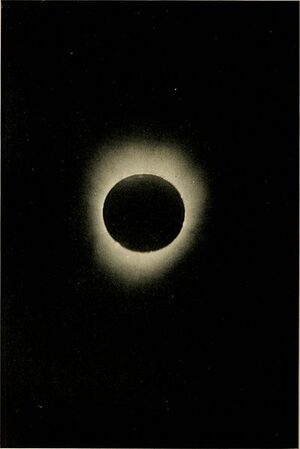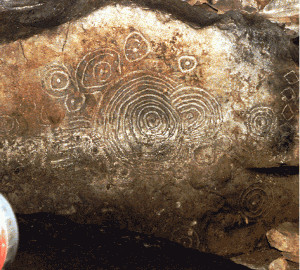Eclipse (nonfiction): Difference between revisions
No edit summary |
No edit summary |
||
| (6 intermediate revisions by the same user not shown) | |||
| Line 1: | Line 1: | ||
[[File:Eclipse.jpg|thumb|Solar eclipse. (Undated; published 1862.)]]An '''eclipse''' is an astronomical event that occurs when an astronomical object is temporarily obscured, either by passing into the shadow of another body or by having another body pass between it and the viewer. An eclipse is a type of syzygy. | [[File:Eclipse.jpg|thumb|Solar eclipse. (Undated; published 1862.)]]An '''eclipse''' is an astronomical event that occurs when an astronomical object is temporarily obscured, either by passing into the shadow of another body or by having another body pass between it and the viewer. An eclipse is a type of syzygy. | ||
== Terminology == | |||
The term eclipse is most often used to describe either a solar eclipse, when the Moon's shadow crosses the Earth's surface, or a lunar eclipse, when the Moon moves into the Earth's shadow. However, it can also refer to such events beyond the Earth–Moon system: for example, a planet moving into the shadow cast by one of its moons, a moon passing into the shadow cast by its host planet, or a moon passing into the shadow of another moon. | The term eclipse is most often used to describe either a solar eclipse, when the Moon's shadow crosses the Earth's surface, or a lunar eclipse, when the Moon moves into the Earth's shadow. However, it can also refer to such events beyond the Earth–Moon system: for example, a planet moving into the shadow cast by one of its moons, a moon passing into the shadow cast by its host planet, or a moon passing into the shadow of another moon. | ||
Records of solar eclipses have been kept since ancient times. Eclipse dates can be used for chronological dating of historical records. A Syrian clay tablet, in the Ugaritic language, records a solar eclipse which occurred on March 5, 1223 B.C., | == Historical record == | ||
Records of solar eclipses have been kept since ancient times, while even more ancient images may depict eclipses. | |||
Eclipse dates can be used for chronological dating of historical records. | |||
=== 3340 BC eclipse === | |||
[[File:Petroglyph_-_Loughcrew_Cairn_L_Megalithic_Monument.jpg|thumb|Petroglyph - Loughcrew Cairn L Megalithic Monument.]]Paul Griffin argues that a stone in Ireland at the Loughcrew Cairn L Megalithic Monument depicts the eclipse of November 30, 3340 B.C. | |||
* [https://web.archive.org/web/20060927064759/http://www.bluhorizonlines.org/discover/discover.html LOUGHCREW CAIRN L MEGALITHIC MONUMENT - OLDCASTLE, COUNTY MEATH, IRELAND] | |||
=== 1223 B.C. eclipse === | |||
A Syrian clay tablet, in the Ugaritic language, records a solar eclipse which occurred on March 5, 1223 B.C. | |||
=== Historical development of eclipse theory === | |||
Positing classical-era astronomers' use of Babylonian eclipse records mostly from the 13th century BC provides a feasible and mathematically consistent explanation for the Greek finding all three lunar mean motions (synodic, anomalistic, draconitic) to a precision of about one part in a million or better. Chinese historical records of solar eclipses date back over 3,000 years and have been used to measure changes in the Earth's rate of spin. | |||
By the 1600s, European astronomers were publishing books with diagrams explaining how lunar and solar eclipses occurred. In order to disseminate this information to a broader audience and decrease fear of the consequences of eclipses, booksellers printed broadsides explaining the event either using the science or via astrology. | |||
== In the News == | == In the News == | ||
<gallery | <gallery> | ||
File:Tycho Brahe.jpg|link=Tycho Brahe (nonfiction)|1560: The occurrence at the predicted time of a solar eclipse in Copenhagen turns [[Tycho Brahe (nonfiction)|Tycho Brahe]] towards a life of observational astronomy. | |||
</gallery> | </gallery> | ||
== Fiction cross-reference == | == Fiction cross-reference == | ||
* [[Crimes against astronomical constants]] | |||
* [[Gnomon algorithm]] | |||
* [[Gnomon Chronicles]] | |||
== Nonfiction cross-reference == | == Nonfiction cross-reference == | ||
External links | * [[Eclipse of Odysseus (nonfiction)]] | ||
== External links == | |||
* [https://en.wikipedia.org/wiki/Eclipse | * [https://en.wikipedia.org/wiki/Eclipse Eclipse] @ Wikipedia | ||
[[Category:Nonfiction (nonfiction)]] | [[Category:Nonfiction (nonfiction)]] | ||
Latest revision as of 08:54, 23 March 2021
An eclipse is an astronomical event that occurs when an astronomical object is temporarily obscured, either by passing into the shadow of another body or by having another body pass between it and the viewer. An eclipse is a type of syzygy.
Terminology
The term eclipse is most often used to describe either a solar eclipse, when the Moon's shadow crosses the Earth's surface, or a lunar eclipse, when the Moon moves into the Earth's shadow. However, it can also refer to such events beyond the Earth–Moon system: for example, a planet moving into the shadow cast by one of its moons, a moon passing into the shadow cast by its host planet, or a moon passing into the shadow of another moon.
Historical record
Records of solar eclipses have been kept since ancient times, while even more ancient images may depict eclipses.
Eclipse dates can be used for chronological dating of historical records.
3340 BC eclipse
Paul Griffin argues that a stone in Ireland at the Loughcrew Cairn L Megalithic Monument depicts the eclipse of November 30, 3340 B.C.
1223 B.C. eclipse
A Syrian clay tablet, in the Ugaritic language, records a solar eclipse which occurred on March 5, 1223 B.C.
Historical development of eclipse theory
Positing classical-era astronomers' use of Babylonian eclipse records mostly from the 13th century BC provides a feasible and mathematically consistent explanation for the Greek finding all three lunar mean motions (synodic, anomalistic, draconitic) to a precision of about one part in a million or better. Chinese historical records of solar eclipses date back over 3,000 years and have been used to measure changes in the Earth's rate of spin.
By the 1600s, European astronomers were publishing books with diagrams explaining how lunar and solar eclipses occurred. In order to disseminate this information to a broader audience and decrease fear of the consequences of eclipses, booksellers printed broadsides explaining the event either using the science or via astrology.
In the News
1560: The occurrence at the predicted time of a solar eclipse in Copenhagen turns Tycho Brahe towards a life of observational astronomy.
Fiction cross-reference
Nonfiction cross-reference
External links
- Eclipse @ Wikipedia


